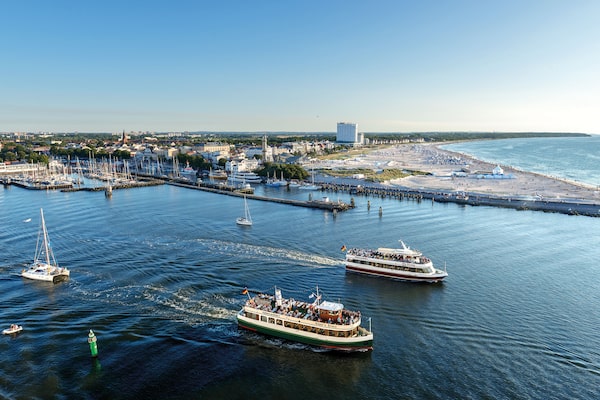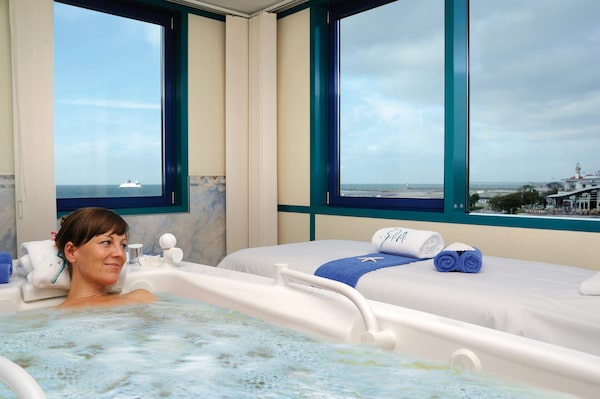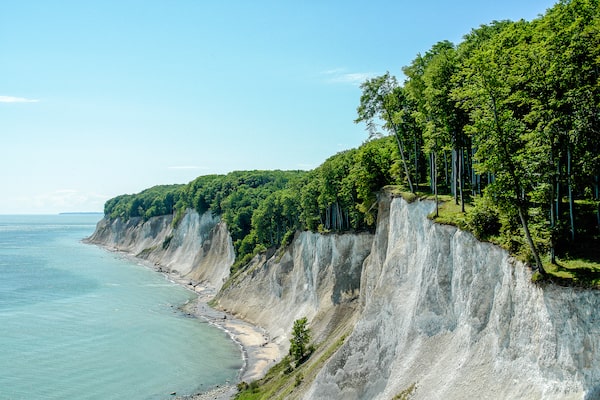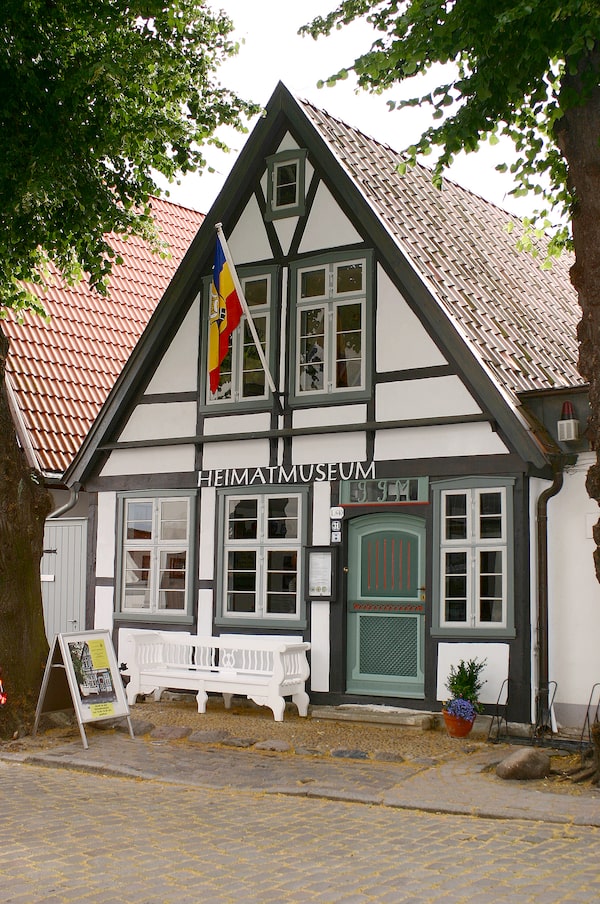
A view of Warnemunde, a resort town about 200 kilometres north of Berlin.HOLGER MARTENS
As I stood alone and lost on a graffiti-splattered train platform in the pitch black of a November night in northeastern Germany, a thought crossed my mind: This was not how I expected my wellness vacation to begin.
I had missed a connecting flight. The airline had left my luggage in Zurich, forcing me to camp at the Berlin airport until my suitcase arrived. I had navigated my way through two train connections, then, disoriented from being awake for 34 hours, I stumbled off the train one stop short of my final destination – which is how I wound up on a platform that evoked every hazy impression I’d ever had of the German Democratic Republic (GDR), the old communist East Germany.
The next morning, having found my hotel and slept like the dead, I awoke to a sight that pulverized my first impression of the place.
Outside my panoramic window was the Baltic Sea, blue-grey and flat as a pane of glass, fringed by a wide, white-sand beach and a fishing village full of restored captains’ homes with peaked, clay-tile roofs.
I had found my way to Warnemunde, a resort town about 200 kilometres north of Berlin, and the first stop on a four-day trip that would also take me to Germany’s largest island, Rugen, a gem virtually unknown to North American travelers. There, I would hike through an ancient beech forest, climb to the top of a Prussian nobleman’s hunting castle and, like a real German, spend hours naked in the co-ed spa.
My goal when I set off for Germany was to feel well, even if only for a few days. It wasn’t that I was unwell, per se. I didn’t have any chronic illnesses that I expected the Baltic Sea air to cure.
But after having three kids in four years, I felt as wrung out as a dish rag. My youngest son is four now and my husband and I are emerging from the trench of early child rearing to occasionally rediscover how sleep (glorious sleep!) and regular exercise can make a person feel. I had begun to crave physical wellbeing as though it were a drug.
So when I got the opportunity to travel to Berlin for a conference, I sought out a wellness-themed side trip to a place that would be easy to reach by train from the German capital.
I traveled to Warnemunde in part to try thalassotherapy, or sea-water therapy, at Hotel Neptun, a tall white box of a resort that looms over the beach, not far from Germany’s busiest cruise ship port.
The hotel, opened in 1971 with an eye to attracting western guests to the GDR, was the first in Germany to be certified as an “Original Thalasso Centre,” a designation handed out to beachfront centres that pump in seawater to fill their swimming pools and the showers and tubs in their treatment rooms.

Hotel Neptun offers thalasso vacations that include daily individual and group seawater treatments, along with more than 30 exercise and relaxation class options.HOLGER MARTENS
Guests can stay for week-long thalasso vacations that include daily individual and group seawater treatments, more than 30 exercise and relaxation class options and – if they choose – a calorie-reduced menu of fresh Baltic Sea fish, salads and steamed veggies that the hotel’s English-language promotional materials refer to as “deliciously slimline.” (At least they have the decency to be honest about my least-favourite part of wellness culture, which is the way “well” has become code for thin because we’re all too embarrassed to admit we’re dieting.)
I didn’t have the time for a full week, but I did try one thalasso treatment, led by a sweet but firm woman who spoke not a word of English.
I showed up in a bathing suit and a robe. She handed me a pair of disposable underwear and then pulled out a jar of a grainy, baby-blue exfoliant and proceeded to scrub me like a pan full of stuck-on grease. I think she removed about seven layers of dead skin. It felt great.
After I showered (with seawater) she covered me with a warm, honey-like liquid and directed me into a warm tub (again, seawater). She poured a brown substance that I can only assume was algae or crushed seaweed into the tub, set a timer and left.
For the next 25 minutes, jets of water moved up and down my body, giving me the gentler equivalent of a vibrating massage-chair treatment. At one point, as I stared out the window at the Baltic sea without a to-do list or a podcast or a Twitter feed to fill my mind, I noticed an unfamiliar sensation. I was daydreaming.

A historical lighthouse in the Hanseatic City of Rostock, of which Warnemunde is a part.Hotel Neptun
Later on, I had the chance to explore Warnemunde, a village that is technically part of Rostock, a Hanseatic city of about 200,000 best known for a university that just celebrated its 600th birthday. As cruise ports go, Warnemunde is more charming than most, its cobblestone streets lined with white cottages that used to belong to fisherman, sailors and shipbuilders, now converted into flats for vacationers.
A wooden carving of Hedwig Anke, a beloved local fishmonger who died in 1983, stands guard outside an excellent little historical museum. Nearby is a house dedicated to the Norwegian artist Edvard Munch, painter of The Scream, who came to Warnemunde in 1907 and 1908 to try to shake off his depression and paranoia. One of his paintings depicts a group of fully nude male Warnemunde lifeguards. (“These lifeguards lost their jobs later,” my tour guide said, “not because they posed naked, but because they did it in their working hours.”)
Cruise-ship passengers and most other international travelers don’t often find their way to my next stop, Ostseebad Binz, the largest resort town on the island of Rugen, a two-hour train ride east of Warnemunde and easily accessible by bridges from the mainland.
The 900-square-kilometre island is the same size as Berlin but with only 77,000 people, compared with nearly four million in the capital. The island, which once belonged to Sweden, then to Prussia, is now part of Mecklenburg-Western Pomerania, the poorest and most rural of Germany’s states.

A stunning coastline of chalk cliffs at the ancient beech forests of Jasmund, Germany’s smallest national park.Peter Lehmann
On Rugen, I found another, more outdoorsy way to satisfy my quest for wellness. Blessed with a rare blue-sky day in November, I drove with a guide from Binz to the nearby town of Sassnitz, where we hiked through the towering, ancient beech forests of Jasmund, Germany’s smallest national park and home to a stunning coastline of chalk cliffs reminiscent of Dover or Calais.
In the afternoon, back in Binz, I hiked up a winding, two-kilometre road to the Jagdschloss Granitz, an ornate, pale pink castle where the Prussian noble family that once owned a third of the island brought friends to hunt deer and wild boar.

The Heimatmuseum in Warnemunde.Heimatmuseum
The castle’s museum is saturated with fascinating Prussian history, but the highlight was walking the winding staircase to the top of the tower for a view across the island, bathed in gold as the sun began to set.
In between my morning and afternoon hikes, my guide and I stopped to see an utterly bizarre reminder of Germany’s dark past. On the road between Sassnitz and Binz sprawls Prora, a 4.5-kilometre long concrete complex that was intended to be a vacation centre, part of Hitler’s “strength through joy,” program.
The Second World War broke out before Prora was opened, leaving the Soviet and East German armies to use the hulking complex periodically before abandoning it after reunification. A small section of it has been turned into a youth hostel. The few international backpackers who find their way to Rugen often ask for directions to the “Hitler hotel,” my guide told me.
Developers are now turning the rest of Prora into seafront vacation flats and investment properties. I visited a sales booth full of the same sleek renderings you’d find at a condo presale centre in Toronto or Vancouver.
On my second full day on Rugen, the weather turned grey and the wind off the Baltic became so wild that I was nearly blown off the long and gorgeous pier in Sellin, another resort town that, similar to Binz, is full of beautiful Spa architecture – whitewashed buildings with ornate, gingerbread-like wooden balconies.
The long and gorgeous pier in Sellin, another resort town full of beautiful Spa architecture.Christian Thiele
Getting to Sellin was half the fun. I rode the Rasender Roland or “Racing Roland,” a narrow-gauge steam train that chugs along at about 30 kilometres an hour, depositing travelers at towns along the shore. Don’t miss the buffetwagen, the train’s kitschy, old German bar car.
On both days, I arrived back at my waterfront hotel, the Grand Hotel Binz, pleasantly exhausted from breathing the sea air and walking all day and made a beeline for the wellness spa. (The hotel also has a Thai Bali spa, where two Ayurvedic practitioners guide guests through a restorative program, often for weeks at a time. The Grand Hotel Binz is one of three properties owned by a German surgeon who is big on preventative health care, but I didn’t have the time – or the inclination – to try the more esoteric side.)
The traditional spa was glorious. I circulated between three saunas: a sweaty Turkish option, a scalding-hot Finnish version and a just-right, scent-infused infrared sauna. I started off in my bathing suit, unable to wrap my head around the idea of strutting naked in front of strange men when I can barely stand to reveal my cottage cheese thighs to my own husband.
Before long, sweating in my tight one piece became uncomfortable, then unbearable. I peeked at the handful of German men and women around me, all of them so obviously at ease in their own bodies. I peeled off my suit and joined them.
By the last night of my vacation, I felt refreshed and care free enough to walk naked into the spa pool and glide around like a dolphin.
If that’s not wellness, I don’t what is.
Your turn
How to get there
Germany’s train system is excellent, with stops right in Warnemunde and in Binz on the island of Rugen. However, if you want to explore Rugen, including Jasmund National Park and its beautiful chalk cliffs, you’d be better off with a rental car. The drive from Berlin to Rugen is about three hours. Bridges links the island to the mainland.
Where to eat
If you’re looking for currywurst or giant pretzels, you’ve come to the wrong part of Germany. The Baltic Sea resorts specialize in smoked and pickled fish, especially herring, cod and salmon.
For a quick serving of smoked fish on an open-faced bun – the local specialty – make your way to the Fischraucherei Kuse, a cozy hut at the far end of Binz’s waterfront promenade, where a fourth-generation fishing family smokes its own catch. A smoked salmon bun and a bottle of beer cost just €5 ($7.31), but you have to bring cash. For beer, try Stortebeker brewed on the mainland in nearby Stralsund, or craft options from Rügen’s brewery, Insel-Brauerei.
If you’re looking for something more filling, try Weltenbummler (Strandpromenade 42 in Binz) where I fell hard for an appetizer translated on the English menu as “Two things from the Smoke.” One was an especially tasty tower of spiced black halibut on a pumpernickel wafer, topped with fresh guacamole.
Another great option is Strandhalle (Strandpromenade 5 in Binz), but be warned: There are no English menus and no English-speaking waiters, at least not on the low-season weeknight when I visited. Tired of fish, I managed to communicate my desire for “fleisch” and out came a plate of steak covered with beet-infused potatoes and topped with a fried egg. It was delicious.
The writer was a guest of the German National Tourist Office. It did not review or approve this article.
An earlier version of this article included a photo of a hotel which was incorrectly labelled. It has been removed.
Live your best. We have a daily Life & Arts newsletter, providing you with our latest stories on health, travel, food and culture. Sign up today
 Kelly Grant
Kelly Grant